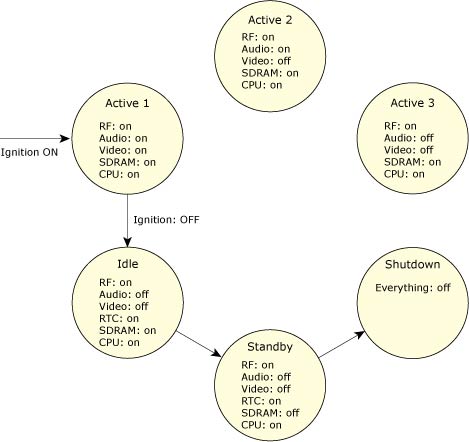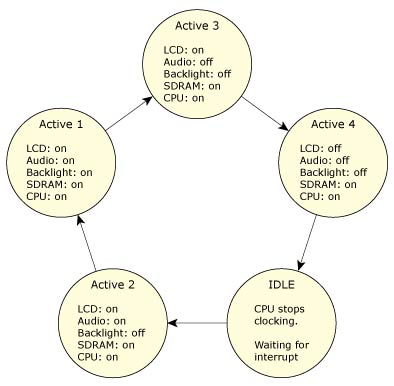![[Previous]](prev.gif) |
![[Contents]](contents.gif) |
![[Next]](next.gif) |
![[Previous]](prev.gif) |
![[Contents]](contents.gif) |
![[Next]](next.gif) |
 |
This version of this document is no longer maintained. For the latest documentation, see http://www.qnx.com/developers/docs. |
This chapter contains the following topics:
Monitoring the power usage of peripherals and controlling its use is a unique challenge for today's electronic and embedded system. QNX neutrino provides all the necessary tools and interfaces (APIs) for controlling the power usage of an embedded system. The most salient feature of QNX Neutrino's power management feature is that users can define their own policy.
Throughout this guide, we often refer to the term power management and the power management policy. Therefore, in this chapter, we describe in brief what we mean by power management as well as its policy and goals. At the end of this chapter, we describe two example systems and their strategies for power management.
Power management is a dynamic computing capability that controls the power use of any device in the system, including add-on boards, such as network adapters or sound cards, as well as RF or Bluetooth devices, navigational aids, printers, keyboards, modems etc. The control procedure, i.e. what determines how and when to save energy, is called the power management policy.
In order to achieve the above purpose, power management addresses the power and performance level of each type of resources in a system. By "system" we refer to electronic systems that are heterogeneous in nature, for example:
The purpose for implementing a power management policy is to:
 |
In addition to the above, QNX Neutrino emphasizes several other policy attributes, such as demanding critical response time or maintaining operational "readiness" over a prolonged period of time. |
There are two distinct categories of systems where power management policy can be applied effectively to control power usage. In one category, a significant class of systems has common characteristics including the following important set:
These characteristics are perhaps best exemplified by in-car computing systems. In a vehicle, a dozen or more secondary-switched devices may continue to draw standby current from the battery when the ignition is off. Under these circumstances, it is necessary to restrict the ignition-off draw of each such device to ensure that the reserve capacity of the battery is not exceeded over a specified interval of time. This ensures that the primary purpose of the battery -- to crank the engine -- is maintained in the presence of any parasitic load from devices.
The importance of the other category grew due to the popularity of laptops, mobile devices, and PDAs. Here the central theme is reducing power consumption through some kind of internal or external events such as:
In this representative example, power conservation is needed when the system is in "off" state, i.e. ignition is off. This is in sharp contrast to the general purpose system where dynamic power management is carried out for an "on" system. The resources we consider include CPU (and SDRAM memory) along with the associated hardware and other devices as follows:
Although the ignition and door locks are the actuators for this system, they are not power managed devices.

Different power modes of an in-car telematics system.
The diagram above shows that the power management policy progressively turns off the devices by transitioning through idle, standby (sleep) or shutdown states. This serves the purpose of restricting standby current drawn from the battery gradually down when the ignition is off. The system can also maintain its readiness to come alive on short notice. For example, the realtime clock (RTC) may be used for timed wakeup out of CPU sleep mode.
A hand-held computer is a representative example of a general purpose system where dynamic power management is carried out for an "on" system. In a hand-held computer, battery life is an important issue, because data will be lost if the battery runs out of power. The following factors will shorten battery life:

Different power modes of a hand-held computer.
The diagram above shows different power modes of a hand-held computer. The strategies for reducing power consumption are:
![[Previous]](prev.gif) |
![[Contents]](contents.gif) |
![[Next]](next.gif) |